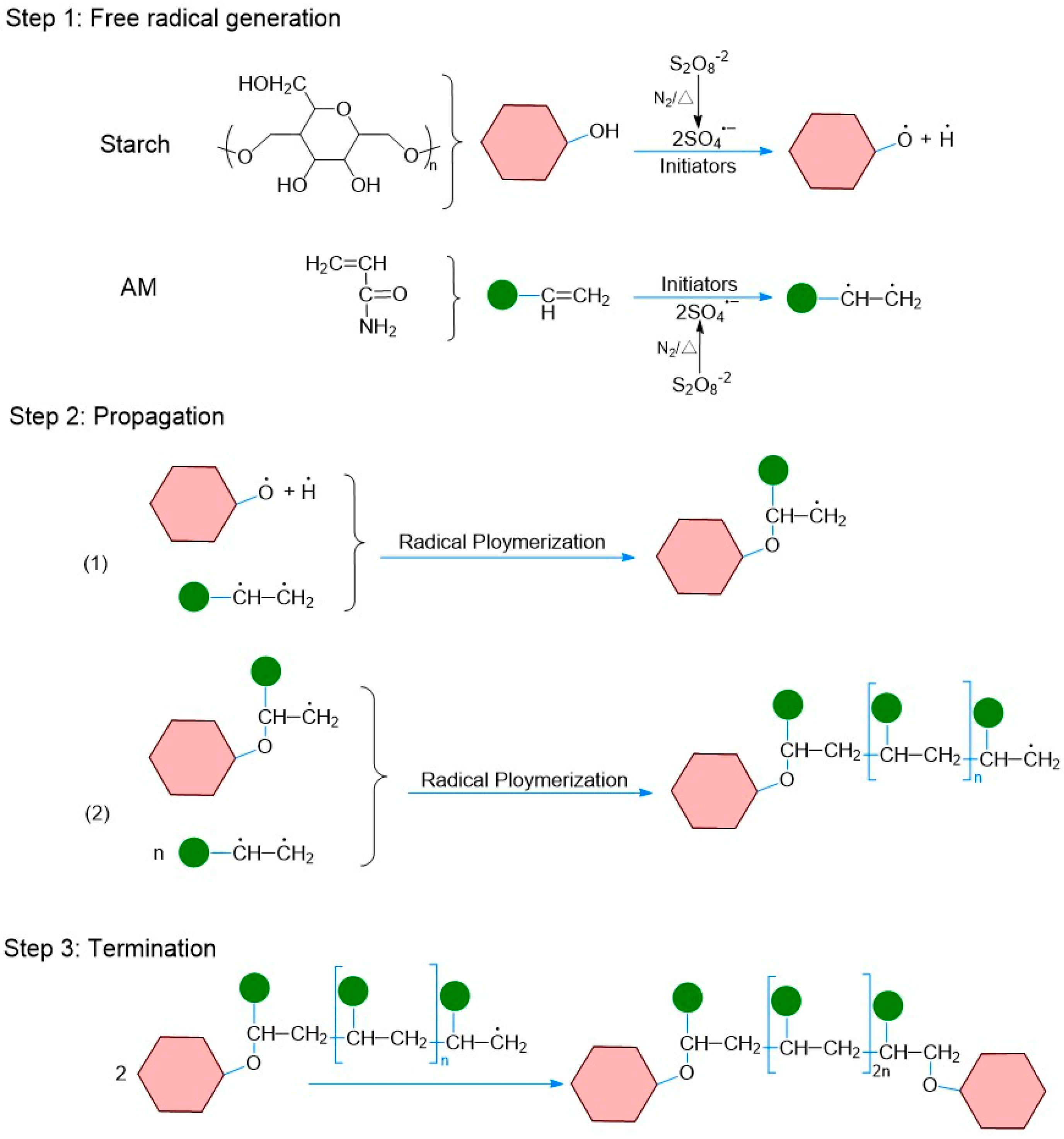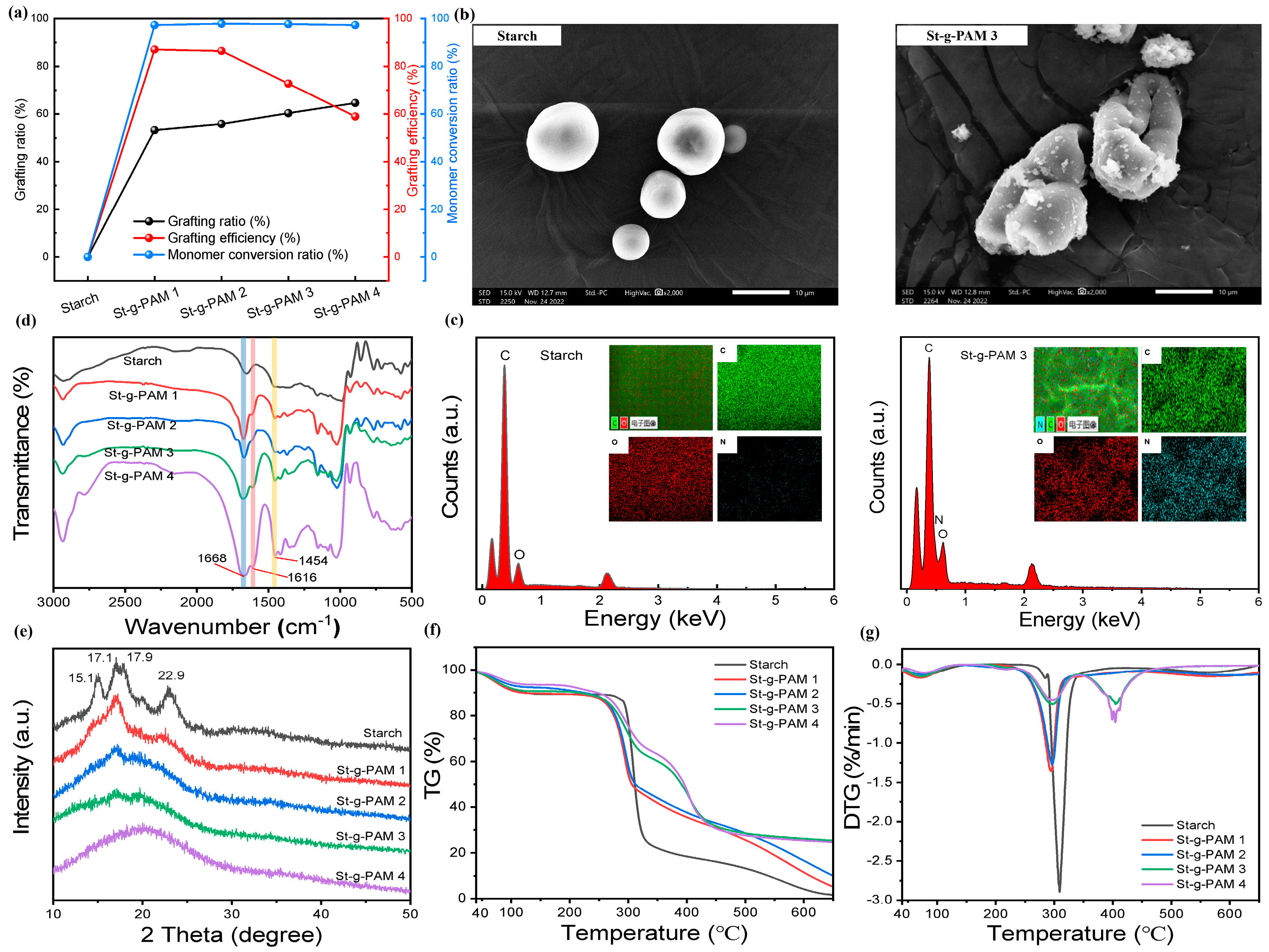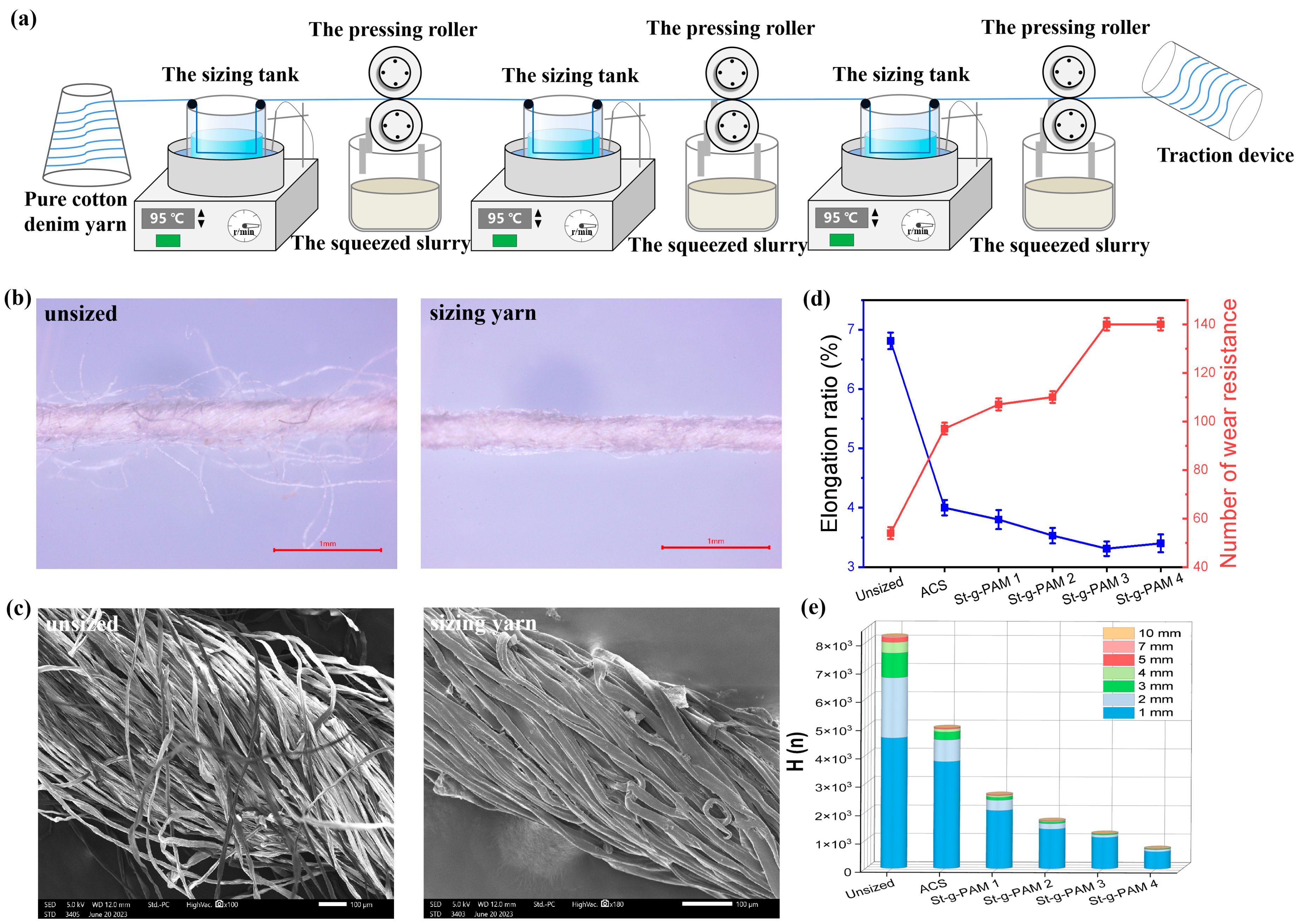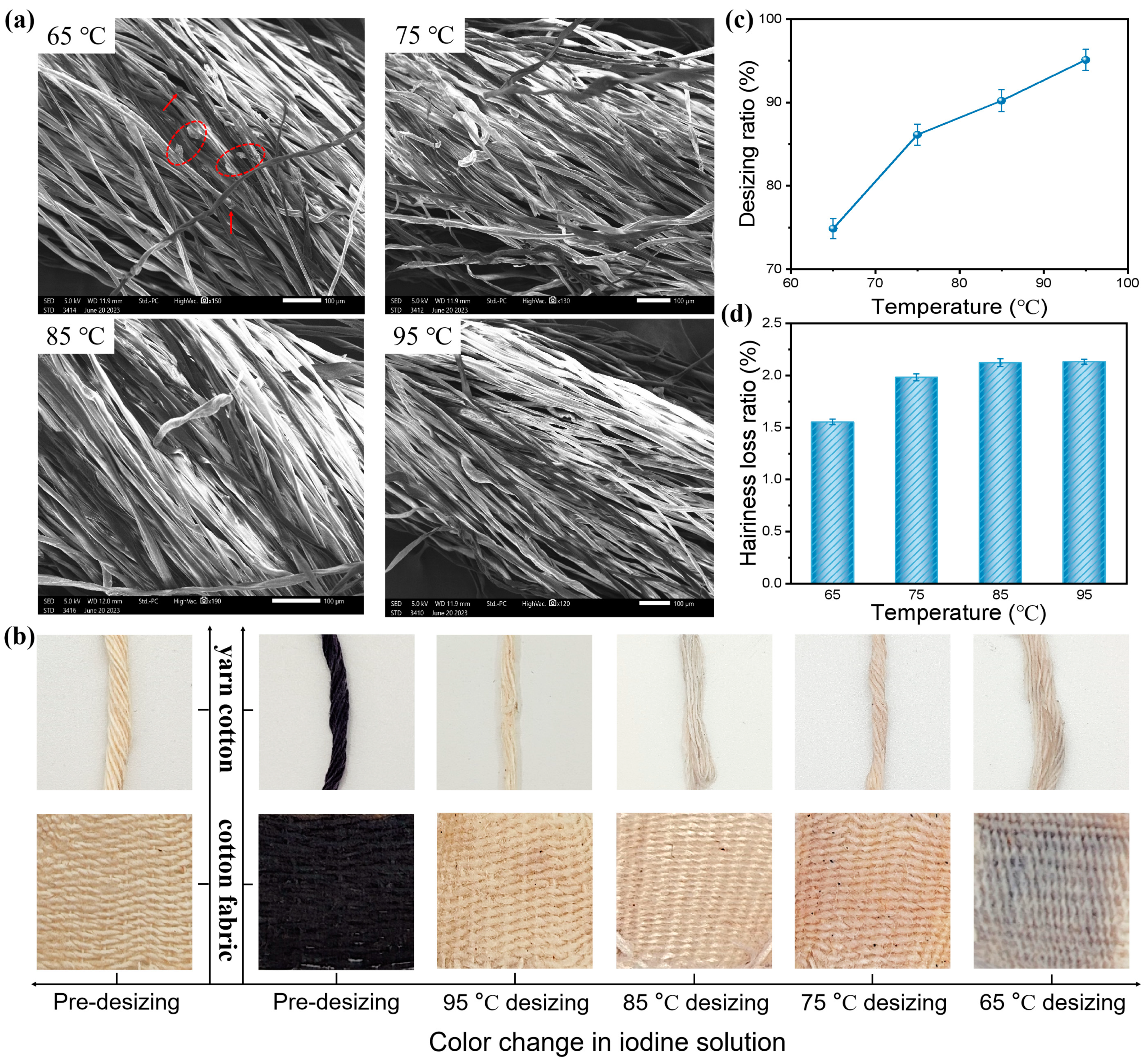Development of a Novel Energy Saving and Environmentally Friendly Starch via a Graft Copolymerization Strategy for Efficient Warp Sizing and Easy Removal
Abstract
1. Introduction
2. Materials and Methods
2.1. Materials
2.2. Preparation of St-g-PAM
2.3. Characterization
3. Results and Discussion
3.1. Grafting Process and Mechanism
3.2. Characterization of St-g-PAM
3.3. Slurry and Film Properties
3.4. Sizing Yarn Morphology and Properties
3.5. Desizing Properties
4. Conclusions
Supplementary Materials
Author Contributions
Funding
Institutional Review Board Statement
Data Availability Statement
Acknowledgments
Conflicts of Interest
References
- Liu, F.; Zhu, Z.; Xu, Z.; Zhang, X. Desizability of the Grafted Starches Used as Warp Sizing agents. Starch-Starke 2018, 70, 3–4. [Google Scholar] [CrossRef]
- Zhu, Z.; Cao, S. Modifications to Improve the Adhesion of Crosslinked Starch Sizes to Fiber Substrates. Text. Res. J. 2004, 74, 253–258. [Google Scholar] [CrossRef]
- Bismark, S.; Xun, Z.; Zhifeng, Z.; Charles, F.; Williams, B.; Benjamin, A.; Ebenezer, H.K. Phosphorylation and Octenylsuccinylation of Acid-Thinned Starch for Enhancing Adhesion on Cotton/Polyester Blend Fibers at Varied Temperature Sizing. Starch-Starke 2018, 71, 1800055. [Google Scholar] [CrossRef]
- Yu, L.; Dean, K.; Li, L. Comprehensive review on single and dual modification of starch: Methods, properties and applications. Int. J. Biol. Macromol. Sci. 2023, 253, 126952. [Google Scholar]
- Tao, K.; Li, C.; Yu, W.; Gilbert, R.G.; Li, E. How amylose molecular fine structure of rice starch affects functional properties. Carbohydr. Polym. 2018, 204, 24–31. [Google Scholar] [CrossRef] [PubMed]
- Li, W.; Zhang, Z.; Wu, L.; Zhu, Z.; Ni, Q.; Xu, Z.; Wu, J. Cross-linking/sulfonation to improve paste stability, adhesion and film properties of corn starch for warp sizing. Int. J. Adhes. Adhes. 2021, 104, 102720. [Google Scholar] [CrossRef]
- Li, W.; Zhu, Z. Electroneutral maize starch by quaterization and sulfosuccination forstrong adhesion-to-viscose fibers and easy removal. J. Adhes. 2015, 92, 257–272. [Google Scholar] [CrossRef]
- Castanha, N.; Lima, D.C.; Junior, M.D.M.; Campanella, O.H.; Augusto, P.E.D. Combining ozone and ultrasound technologies to modify maize starch. Int. J. Biol. Macromol. 2019, 139, 63–74. [Google Scholar] [CrossRef]
- Mostafa, K.M.; El-Sanabary, A.A. Harnessing of novel tailored modified pregelled starch-derived products in sizing of cotton textiles. Adv. Polym. Technol. 2011, 31, 52–62. [Google Scholar] [CrossRef]
- Bao, X.; Yu, L.; Shen, S.; Simon, G.P.; Liu, H.; Chen, L. How rheological behaviors of concentrated starch affect graft copolymerization of acrylamide and resultant hydrogel. Carbohydr. Polym. 2019, 219, 395–404. [Google Scholar] [CrossRef]
- Pourmahdi, M.; Abdollahi, M.; Nasiri, A. Effect of lignin source and initiation conditions on graft copolymerization of lignin with acrylamide and performance of graft copolymer as additive in water-based drilling fluid. J. Pet. Sci. Eng. 2023, 220, 111253. [Google Scholar] [CrossRef]
- Bolat, K.; Hasanoğlu, A.; Seçer, A. Use of modified corn starches as environmental and cost-friendly alternatives of PVA in sizing applications. J. Text. Inst. 2020, 112, 1688–1699. [Google Scholar] [CrossRef]
- Jiang, T.; Chen, F.; Duan, Q.; Bao, X.; Jiang, S.; Liu, H.; Chen, L.; Yu, L. Designing and application of reactive extrusion with twice initiations for graft copolymerization of acrylamide on starch. Eur. Polym. J. 2022, 165, 111008. [Google Scholar] [CrossRef]
- Siyamak, S.; Luckman, P.; Laycock, B. Rapid and solvent-free synthesis of pH-responsive graft-copolymers based on wheat starch and their properties as potential ammonium sorbents. Int. J. Biol. Macromol. 2020, 149, 477–486. [Google Scholar] [CrossRef] [PubMed]
- Zhu, Z.; Zhu, Z. Adhesion of starch-g-poly(2-acryloyloxyethyl trimethyl ammonium chloride) to cotton and polyester fibers. Starch-Starke 2014, 66, 566–575. [Google Scholar] [CrossRef]
- Zha, X.; Sadi, S.; Yang, Y.; Luo, T.; Huang, N. Introduction of poly(acrylic acid) branch onto acetate starch for polyester warp sizing. J. Text. Inst. 2020, 112, 273–285. [Google Scholar] [CrossRef]
- Zhu, Z.; Wang, M.; Li, W. Starch maleation and sulfosuccinylation to alleviate the intrinsic drawback of brittleness of cornstarch film for warp sizing. Fibers Polym. 2015, 16, 1890–1897. [Google Scholar] [CrossRef]
- Djordjevic, S.; Kovacevic, S.; Nikolic, L.; Miljkovic, M.; Djordjevic, D. Cotton Yarn Sizing by Acrylamide Grafted Starch Copolymer. J. Nat. Fibers 2014, 11, 212–224. [Google Scholar] [CrossRef]
- Obadi, M.; Qi, Y.; Xu, B. High-amylose maize starch: Structure, properties, modifications and industrial applications. Carbohydr. Polym. 2023, 299, 120185. [Google Scholar] [CrossRef]
- Zhang, X.; Baek, N.-W.; Lou, J.; Xu, J.; Yuan, J.; Fan, X. Effects of exogenous proteins on enzyme desizing of starch and its mechanism. Int. J. Biol. Macromol. 2022, 218, 375–383. [Google Scholar] [CrossRef]
- Tu, Y.; Shao, G.; Zhang, W.; Chen, J.; Qu, Y.; Zhang, F.; Tian, S.; Zhou, Z.; Ren, Z. The degradation of printing and dyeing wastewater by manganese-based catalysts. Sci. Total. Environ. 2022, 828, 154390. [Google Scholar] [CrossRef]
- Zhou, H.; Zhou, L.; Ma, K. Microfiber from textile dyeing and printing wastewater of a typical industrial park in China: Occurrence, removal and release. Sci. Total. Environ. 2020, 739, 140329. [Google Scholar] [CrossRef] [PubMed]
- Shahzad, H.M.A.; Khan, S.J.; Zeshan; Jamal, Y.; Habib, Z. Evaluating the performance of anaerobic moving bed bioreactor and upflow anaerobic hybrid reactor for treating textile desizing wastewater. Biochem. Eng. J. 2021, 174, 108123. [Google Scholar] [CrossRef]
- Liu, S.-S.; You, W.-D.; Chen, C.-E.; Wang, X.-Y.; Yang, B.; Ying, G.-G. Occurrence, fate and ecological risks of 90 typical emerging contaminants in full-scale textile wastewater treatment plants from a large industrial park in Guangxi, Southwest China. J. Hazard. Mater. 2023, 449, 131048. [Google Scholar] [CrossRef] [PubMed]
- Zhu, Z.; Chen, P. Carbamoyl ethylation of starch for enhancing the adhesion capacity to fibers. J. Appl. Polym. Sci. 2007, 106, 2763–2768. [Google Scholar] [CrossRef]
- Li, W.; Xu, Z.; Wang, Z.; Liu, X.; Li, C.; Ruan, F. Double etherification of corn starch to improve its adhesion to cotton and polyester fibers. Int. J. Adhes. Adhes. 2018, 84, 101–107. [Google Scholar] [CrossRef]
- Li, L.; Yang, J. Quantifying the microstructure evolution and phase assemblage of solid waste as construction materials by EDS image analysis: A case study of carbonated basic oxygen furnace slag aggregates. Constr. Build. Mater. 2023, 393, 131892. [Google Scholar] [CrossRef]
- Nguyen, L.N.; Vu, H.P.; Fu, Q.; Johir, A.H.; Ibrahim, I.; Mofijur, M.; Labeeuw, L.; Pernice, M.; Ralph, P.J.; Nghiem, L.D. Synthesis and evaluation of cationic polyacrylamide and polyacrylate flocculants for harvesting freshwater and marine microalgae. Chem. Eng. J. 2021, 433, 133623. [Google Scholar] [CrossRef]
- Wang, L.; Zhang, X.; Xu, J.; Wang, Q.; Fan, X. How starch-g-poly(acrylamide) molecular structure effect sizing properties. Int. J. Biol. Macromol. 2019, 144, 403–409. [Google Scholar] [CrossRef]
- Shen, Y.; Yao, Y.; Wang, Z.; Wu, H. Hydroxypropylation reduces gelatinization temperature of corn starch for textile sizing. Cellulose 2021, 28, 5123–5134. [Google Scholar] [CrossRef]
- Mishra, S.; Mukul, A.; Sen, G.; Jha, U. Microwave assisted synthesis of polyacrylamide grafted starch (St-g-PAM) and its applicability as flocculant for water treatment. Int. J. Biol. Macromol. 2011, 48, 106–111. [Google Scholar] [CrossRef] [PubMed]
- Chen, Y.; Duan, Q.; Zhu, J.; Liu, H.; Chen, L.; Yu, L. Anchor and bridge functions of APTES layer on interface between hydrophilic starch films and hydrophobic soyabean oil coating. Carbohydr. Polym. 2021, 272, 118450. [Google Scholar] [CrossRef] [PubMed]
- Zhang, L.; Xiong, T.; Wang, X.-F.; Chen, D.-L.; He, X.-D.; Zhang, C.; Wu, C.; Li, Q.; Ding, X.; Qian, J.-Y. Pickering emulsifiers based on enzymatically modified quinoa starches: Preparation, microstructures, hydrophilic property and emulsifying property. Int. J. Biol. Macromol. 2021, 190, 130–140. [Google Scholar] [CrossRef] [PubMed]
- Lee, H.; Kim, H.-S. Pasting and paste properties of waxy rice starch as affected by hydroxypropyl methylcellulose and its viscosity. Int. J. Biol. Macromol. 2019, 153, 1202–1210. [Google Scholar] [CrossRef] [PubMed]
- Li, W.; Yu, Z.; Wu, Y.; Liu, Q. Preparation, characterization of feather protein-g-poly(sodium allyl sulfonate) and its application as a low-temperature adhesive to cotton and viscose fibers for warp sizing. Eur. Polym. J. 2020, 136, 109945. [Google Scholar] [CrossRef]
- Li, W.; Zhang, Z.; Wu, L.; Liu, Q.; Cheng, X.; Xu, Z. Investigating the relationship between structure of itaconylated starch and its sizing properties: Viscosity stability, adhesion and film properties for wool warp sizing. Int. J. Biol. Macromol. 2021, 181, 291–300. [Google Scholar] [CrossRef]
- Li, W.; Wu, L.; Zhang, Z.; Ke, H.; Liu, Q.; Zhu, Z.; Xu, Z.; Wei, A.; Cheng, X. Introduction of poly(2-acrylamide-2-methylpro panesulfonic acid) branches into starch molecules for improving its paste stability, adhesion and desizability. Int. J. Adhes. Adhes. 2021, 110, 102939. [Google Scholar] [CrossRef]
- Li, W.; Wu, L.; Zhu, Z.; Zhang, Z.; Liu, Q.; Lu, Y.; Ke, H. Incorporation of poly(sodium allyl sulfonate) branches on corn starch chains for enhancing its sizing properties: Viscosity stability, adhesion, film properties and desizability. Int. J. Biol. Macromol. 2020, 166, 1460–1470. [Google Scholar] [CrossRef]





| St-g-PAM | 1788PVA | 1799PVA | |
|---|---|---|---|
| BOD5 (mg/L) | 39,400 | 1630 | 800 |
| CODcr (mg/L) | 82,773 | 181,000 | 182,000 |
| BOD5/CODcr | 0.476 | 0.009 | 0.004 |
Disclaimer/Publisher’s Note: The statements, opinions and data contained in all publications are solely those of the individual author(s) and contributor(s) and not of MDPI and/or the editor(s). MDPI and/or the editor(s) disclaim responsibility for any injury to people or property resulting from any ideas, methods, instructions or products referred to in the content. |
© 2024 by the authors. Licensee MDPI, Basel, Switzerland. This article is an open access article distributed under the terms and conditions of the Creative Commons Attribution (CC BY) license (https://creativecommons.org/licenses/by/4.0/).
Share and Cite
Zhu, Y.; Guo, F.; Li, J.; Wang, Z.; Liang, Z.; Yi, C. Development of a Novel Energy Saving and Environmentally Friendly Starch via a Graft Copolymerization Strategy for Efficient Warp Sizing and Easy Removal. Polymers 2024, 16, 182. https://doi.org/10.3390/polym16020182
Zhu Y, Guo F, Li J, Wang Z, Liang Z, Yi C. Development of a Novel Energy Saving and Environmentally Friendly Starch via a Graft Copolymerization Strategy for Efficient Warp Sizing and Easy Removal. Polymers. 2024; 16(2):182. https://doi.org/10.3390/polym16020182
Chicago/Turabian StyleZhu, Yuhan, Fei Guo, Jing Li, Zhen Wang, Zihui Liang, and Changhai Yi. 2024. "Development of a Novel Energy Saving and Environmentally Friendly Starch via a Graft Copolymerization Strategy for Efficient Warp Sizing and Easy Removal" Polymers 16, no. 2: 182. https://doi.org/10.3390/polym16020182
APA StyleZhu, Y., Guo, F., Li, J., Wang, Z., Liang, Z., & Yi, C. (2024). Development of a Novel Energy Saving and Environmentally Friendly Starch via a Graft Copolymerization Strategy for Efficient Warp Sizing and Easy Removal. Polymers, 16(2), 182. https://doi.org/10.3390/polym16020182





